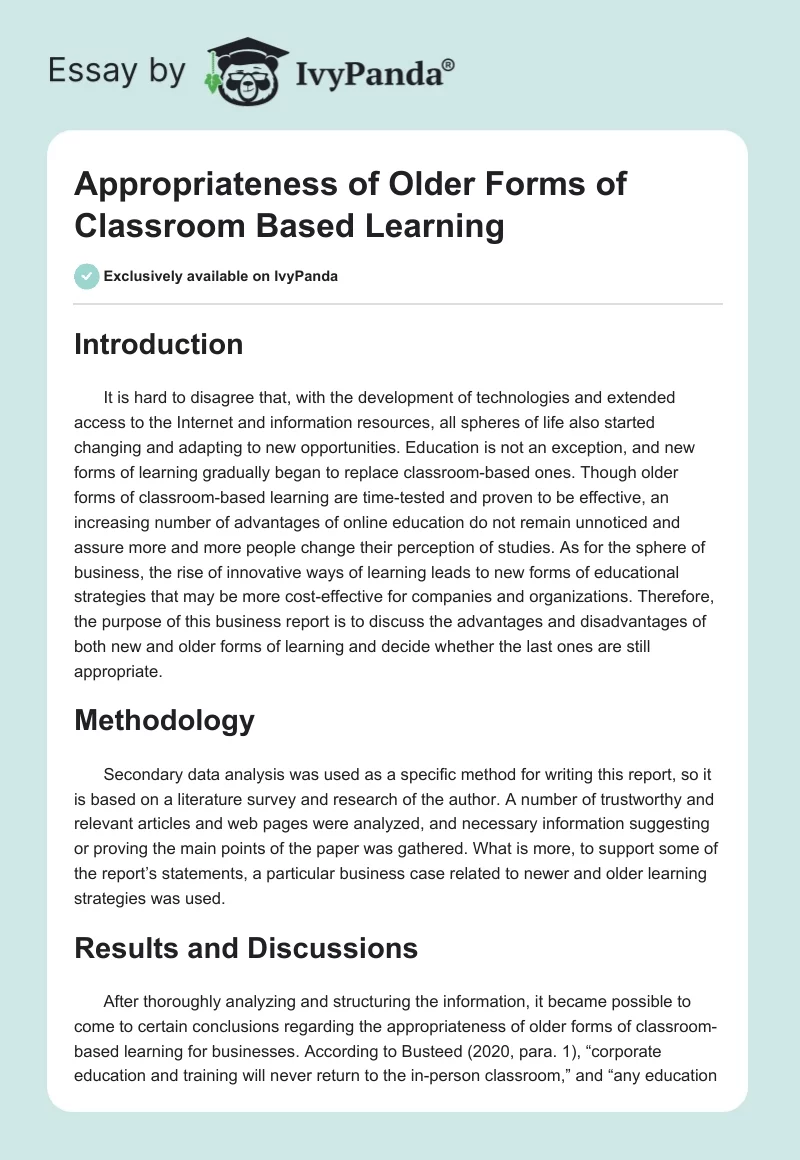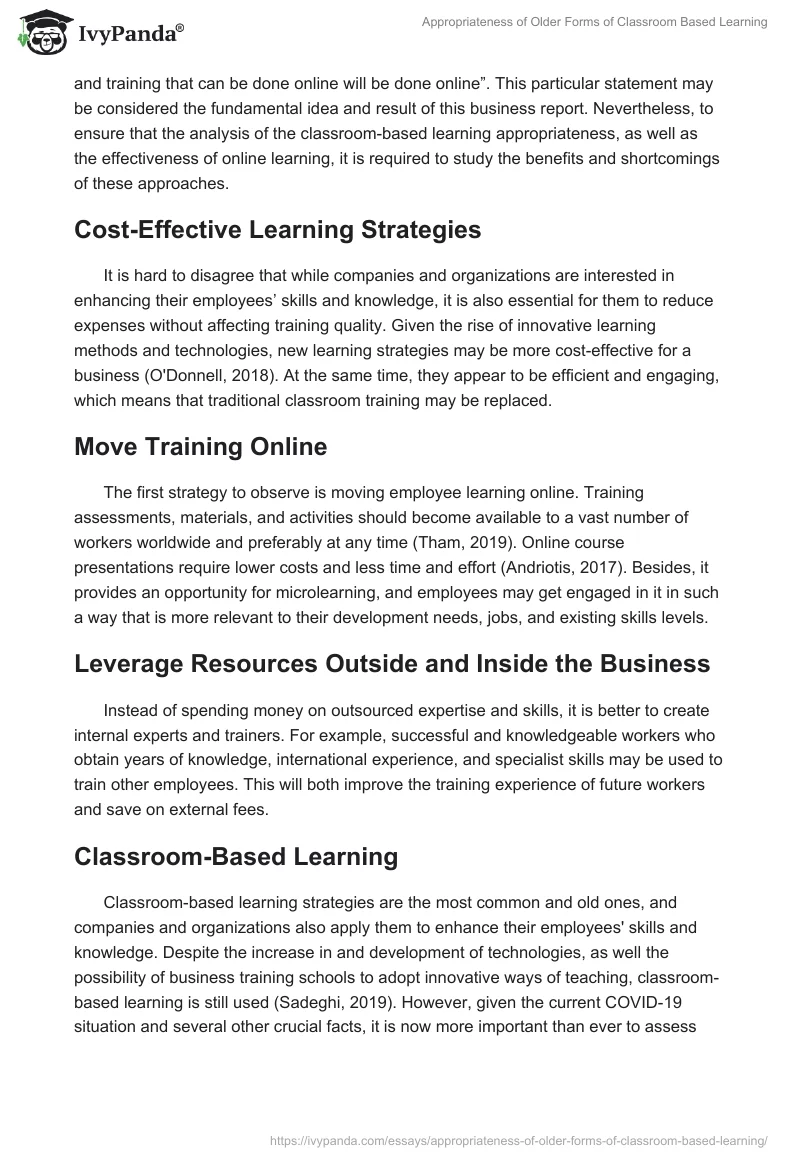Introduction
It is hard to disagree that, with the development of technologies and extended access to the Internet and information resources, all spheres of life also started changing and adapting to new opportunities. Education is not an exception, and new forms of learning gradually began to replace classroom-based ones. Though older forms of classroom-based learning are time-tested and proven to be effective, an increasing number of advantages of online education do not remain unnoticed and assure more and more people change their perception of studies. As for the sphere of business, the rise of innovative ways of learning leads to new forms of educational strategies that may be more cost-effective for companies and organizations. Therefore, the purpose of this business report is to discuss the advantages and disadvantages of both new and older forms of learning and decide whether the last ones are still appropriate.
Methodology
Secondary data analysis was used as a specific method for writing this report, so it is based on a literature survey and research of the author. A number of trustworthy and relevant articles and web pages were analyzed, and necessary information suggesting or proving the main points of the paper was gathered. What is more, to support some of the report’s statements, a particular business case related to newer and older learning strategies was used.
Results and Discussions
After thoroughly analyzing and structuring the information, it became possible to come to certain conclusions regarding the appropriateness of older forms of classroom-based learning for businesses. According to Busteed (2020, para. 1), “corporate education and training will never return to the in-person classroom,” and “any education and training that can be done online will be done online”. This particular statement may be considered the fundamental idea and result of this business report. Nevertheless, to ensure that the analysis of the classroom-based learning appropriateness, as well as the effectiveness of online learning, it is required to study the benefits and shortcomings of these approaches.
Cost-Effective Learning Strategies
It is hard to disagree that while companies and organizations are interested in enhancing their employees’ skills and knowledge, it is also essential for them to reduce expenses without affecting training quality. Given the rise of innovative learning methods and technologies, new learning strategies may be more cost-effective for a business (O’Donnell, 2018). At the same time, they appear to be efficient and engaging, which means that traditional classroom training may be replaced.
Move Training Online
The first strategy to observe is moving employee learning online. Training assessments, materials, and activities should become available to a vast number of workers worldwide and preferably at any time (Tham, 2019). Online course presentations require lower costs and less time and effort (Andriotis, 2017). Besides, it provides an opportunity for microlearning, and employees may get engaged in it in such a way that is more relevant to their development needs, jobs, and existing skills levels.
Leverage Resources Outside and Inside the Business
Instead of spending money on outsourced expertise and skills, it is better to create internal experts and trainers. For example, successful and knowledgeable workers who obtain years of knowledge, international experience, and specialist skills may be used to train other employees. This will both improve the training experience of future workers and save on external fees.
Classroom-Based Learning
Classroom-based learning strategies are the most common and old ones, and companies and organizations also apply them to enhance their employees’ skills and knowledge. Despite the increase in and development of technologies, as well the possibility of business training schools to adopt innovative ways of teaching, classroom-based learning is still used (Sadeghi, 2019). However, given the current COVID-19 situation and several other crucial facts, it is now more important than ever to assess whether such a learning type is still appropriate. Studying its advantages and disadvantages may assist in solving this question.
Advantages
To begin with, a vast number of benefits of traditional classroom training that provide extra value and efficiency to any training experience were identified. First of all, the design of classroom-based learning is explicitly aimed at engaging the learners and keeping them concentrated on the curriculum with minimum distractions (Sadeghi, 2019). Taking into account that employees are usually tired or thinking about their business duties, classroom training is the best option to make them pay more attention to their studies without their coworkers or working emails distracting them.
Next, traditional classroom training provides an increased possibility for group interaction, which is also critical for adult learners. For example, if a worker is attending supervisory or human resources training, he or she has a chance to exchange some essential lessons, stories, and insights with other like-professionals. Such interaction enhances learners’ gained skills and experience (Sadeghi, 2019). Given the necessity of obtaining such practice, including general interpersonal skills, this is a great advantage of classroom-based learning.
Finally, traditional learning approaches are characterized by an increased number of human elements involved. According to Tyng et al. (2017), adult learners typically use their emotions to retain and gain the necessary knowledge, skills, and information. However, e-learning or online lectures may cause the learners to miss some crucial human behaviors that can awaken emotions connected to learning. Practically, these are the main advantages, and decades ago, when technologies were not advanced enough, these benefits were rather convincing. Nevertheless, current possibilities allow to keep students engaged, emotionally involved, and able to have group interactions even during other types of training.
Disadvantages
The disadvantages of such type of learning may be considered serious and impressive, especially considering the current global pandemic and lockdowns. To begin with, learners have to spend time on the road, which can lead to early work leaving for an extended period. For example, Mohammed wanted to start attending a new CIPD Course based at Loughborough college and would have to leave work early every Tuesday for a month. Such changes and the tiresome road may have an adverse impact on employees’ productivity both at the workplace and in studies.
Second, traditional classroom training is characterized by an increase in companies’ and organizations’ spending. This is a major disadvantage that may lead to a decreased number of employees obtaining training. For example, O’Donnel (2018, para. 1) notices that “almost one-third (31%) of employees were offered no formal training in 2016; 43% who received training found it to be ineffective”. These facts may be the result of expenses needed for providing classroom-based learning. According to Busteed (2020, para. 2), “the expense and time of bringing together groups of employees for in-person training are exorbitant in comparison to high-quality online versions”. What is more, chief learning and human resource officers believe that “the risk liability of group training events and, frankly, the poor quality and unmeasurable outcomes of in-person corporate training have always been complaints” (Busteed, 2020, para. 2). These disadvantages seem convincing and are difficult to be eliminated.
Evaluation of Its Appropriateness
The negative and positive features of classroom-based learning mentioned above make it possible to suggest that it is better and more beneficial for businesses not to return to face-to-face education after the pandemic is over. Researchers note that traditional classroom training is not enough for today’s employees since it is “not be the best way to educate groups” (O’Donnell, 2018, para. 3). It is not a proper way to teach adults who work and need to get information quicker and in a more practical way (Stewart and Rigg, 2011). Hence, classroom-based learning for businesses should and is likely to be left behind.
Conclusion
To draw a conclusion, it is possible to state that innovative types of learning become more and more accepted and beneficial. They are proven to be efficient and cost-effective and provide employees with necessary and quality skills and knowledge. As for the appropriateness of traditional classroom training, it is possible to suggest that it is not as beneficial as it used to be decades ago. Therefore, businesses are unlikely and not recommended to return to it after the COVID-19 situation is over.
Reference List
Andriotis, N. (2017) ‘Reduce the cost of training employees with these simple techniques’, eLearning Industry. Web.
Busteed, B. (2020) ‘Corporate education will never return to the classroom’, Forbes. Web.
O’Donnell, R. (2018) ‘Why traditional classroom training isn’t enough for today’s employee’, HRDive. Web.
Sadeghi, M. (2019) ‘A shift from classroom to distance learning: advantages and limitations’, International Journal of Research in English Education, 4(1), pp. 80-88.
Stewart, J. and Rigg, C. (2011) Learning and talent development. London: Chartered Institute of Personnel and Development.
Tham, M. S. F. (2019) ‘Why a digital learning strategy is crucial for success’, eLearning Industry. Web.
Tyng, C. M. et al. (2017) ‘The influences of emotion on learning and memory’, Frontiers in Psychology, 8, 1454.


